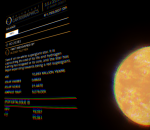that out of the way, back to the f/g confused super giants.
None of you really have to go anywhere and visit potential f/g confused stars yourself.
I am doing it and bringing the evidence, so y'all don't have to

What should happen though is that a decision is made. If I am right, and G-Type super giants have a description of F-Type super giants by error.
That would on the one hand mean. Some stars are eligible under the G-Type category. Which are now not. Which is the smaller of the issues.
The bigger one would be. Some F-Star records based on F-star super giant descriptions might actually be G-Type ones. And exisiting records would have to be checked
against the galaxy map type description.
And future F/G super giant submissions would need to include a galaxy map screenshot.
I think I am pretty done with running all over collecting evidence. Found 2 more yesterday. Another F/G confused super giant. And a F/F unconfused super giant. The last
one is important for "color" reasons.
So let me present my findings that are spread out over many posts all here in one place:
Here's the list of f/g confused super giants. For all six supergiants, the galaxy map says g-type. the system map says f-type super giant:
if I might make your retina pay special attention to the color of each and every one of those stars in the system map. The well known by most of us G-type yellow-orangy color.
And here's the f/f unconfused super giant. where galaxy map and system map both say type F:
again, put your retinas focus on system map coloring of the super giant. The well known white-yellowish scheme we all recognize as F-type.
I can only come to one conclusion. description of g-type super giants is wrong in the system map and says f-type super giant instead. Result of that is some f-type records might be wrong....
I want to get back to civilised space for 1.2 and turn in my 1700 systems explored and hope it will be sufficient for pioneer. And hop in a vulture and fdl and give them a spin around combat zones.
I kinda like equilibrium among my ranks and going from dangerous to deadly would feel balanced with the pioneer from ranger ;-)
Anyway. I might pick up some more f/g, f/f super giants if I happen to be close by. But my zipping all over the place to collect them days are definitely over. ;-)









































